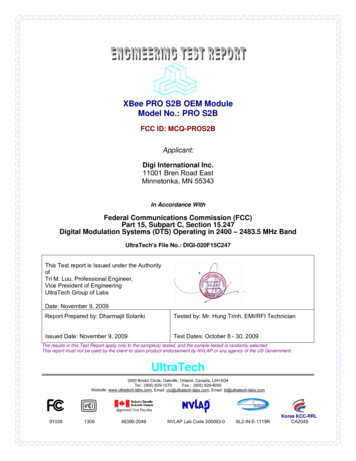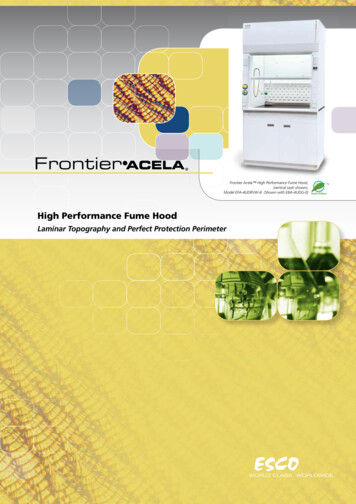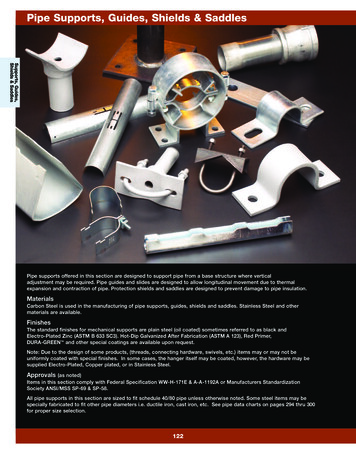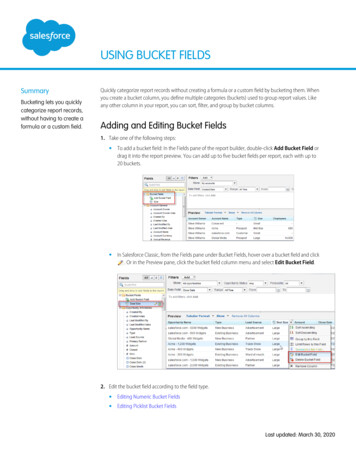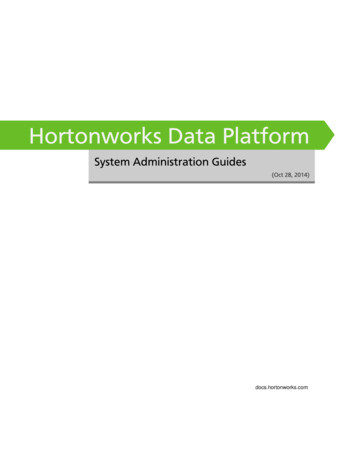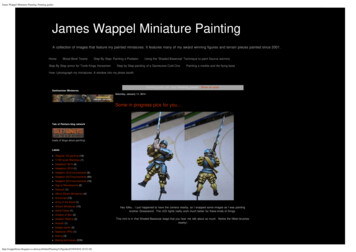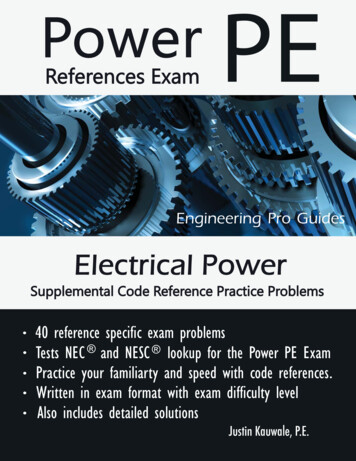
Transcription
PowerReferences ExamPEEngineering Pro GuidesElectrical PowerSupplemental Code Reference Practice Problems40 reference specific exam problemsTests NEC and NESC lookup for the Power PE ExamPractice your familiarty and speed with code references.Written in exam format with exam difficulty levelAlso includes detailed solutionsJustin Kauwale, P.E.
SECTION 1INTRODUCTIONhttp://www.engproguides.com
IntroductionTable of Contents1.0 Introduction . 21.1 Key Concepts and Skills . 21.2 Units . 62.0 Disclaimer . 63.0 How to use this Book . 64.0 Sample Exam Tips . 75.0Recommended References . 105.1NFPA 70, NEC Handbook, 2014 Edition . 145.2Schaum's Outline of Basic Electricity . 155.3Schaum's Outline of Electrical Power Systems . 155.4Electric Machines, Drives and Power Systems . 165.5Power System Analysis . 165.6Fundamentals of Power System Protection . 165.7Online Articles . 175.8IEEE Color Books . 185.9National Electrical Safety Code (NESC ) . 195.10NFPA 70E, 497, 499 & 30B . 205.1.1NFPA 70E . 205.1.2NFPA 497 – Recommended Practice for the Classification of Flammable Liquids,Gases, or Vapors and of Hazardous (classified) Locations for Electrical Installations inChemical Process Areas . 205.1.3NFPA 499 – Recommended Practice for the Classification of Combustible Dustsand of Hazardous (Classified) Locations for Electrical Installations in Chemical ProcessAreas 205.1.4NFPA 30B – Code for the Manufacture and Storage of Aerosol Products . 21Introduction-1http://www.engproguides.com
1.0 INTRODUCTIONOne of the most important steps in an engineer's career is obtaining the professionalengineering (P.E.) license. It allows an individual to legally practice engineering in the state oflicensure. This credential can also help to obtain higher compensation and develop a crediblereputation. In order to obtain a P.E. license, the engineer must first meet the qualifications asrequired by the state of licensure, including minimum experience, references, and the passing ofthe National Council of Examiners for Engineering and Surveying (NCEES) exam. EngineeringPro Guides focuses on helping engineers pass the NCEES exam through the use of freecontent on the website, http://www.engproguides.com and through the creation of books likesample exams and guides that outline how to pass the PE exam.The first key to passing the PE exam is to learn the key concepts and skills that are tested onthe exam. There are several issues that make this very difficult. First, the key concepts andskills are unknown to most engineers studying for the exam. Second, the key concepts andskills are not contained in a single document. The technical guide teaches you the keyconcepts and skills required to pass the Electrical Power PE Exam. The second key is beingable to navigate and understand your Power PE references. In practice, a deep understandingof your references is necessary to be a successful engineer. These references containapplicable codes and standards. Your understanding of these references is tested on thePower PE exam. The reference exam makes you familiar with the key parts of your Power PEreferences by pushing you to navigate your references to solve sample exam problems.1.1 KEY CONCEPTS AND SKILLSHow are the key concepts and skills determined?The key concepts and skills tested in this sample exam were first developed through an analysisof the topics and information presented by NCEES. NCEES indicates on their website that thePE Exam will cover an AM exam (4 hours) followed by a PM exam (4 hours) and that the examwill be 80 questions long, 40 questions in the morning and 40 questions in the afternoon. ThePower Electrical PE exam will focus on the following topics, as indicated by NCEES.(http://ncees.org/engineering/pe/):I.General Power Engineering (24 questions)A) Measurement and Instrumentation (4 questions)1 Instrument transformers2 Insulation testing3 Ground resistance testingB) Special Applications (8 questions)1 Lightning protection2 Surge protection3 Reliability4 Illumination/lighting and energy efficiency engineering5 Demand calculations6 Energy m
7 Engineering economics8 GroundingC) Codes and Standards (12 questions)1 National Electrical Code (NFPA 70, NEC 2017)2 National Electrical Safety Code (ANSI C2, NESC)3 Standard for Electrical Safety in the Workplace: Shock and Burns (NFPA 70E)4 Hazardous Area Classification (NFPA 497, 499, 30B)II.Circuits(16 questions)A) Analysis (9 questions)1 Three-phase circuits2 Symmetrical components3 Per unit system4 Phasor diagrams5 Single phase circuits6 DC circuits7 Single-line diagramsB) Devices and Power Electronic Circuits (7 questions)1 Battery characteristics and ratings2 Power supplies3 Relays, switches and PLCs4 Variable speed drivesIII.Rotating Machines and Electromagnetic Devices (16 questions)A) Rotating Machines (8 questions)1 Induction and Synchronous Machinesi) Generator/motor applicationsii) Equivalent circuits and characteristicsiii) Motor startingiv) Electrical machine theoryB) Electric Power Devices (8 questions)1 Transformers2 Reactors3 Testing4 CapacitorsIV.Transmission and Distribution (High, Medium and Low Voltage) (24 questions)A) Power System Analysis (11 questions)1 Voltage drop2 Voltage regulation3 Power factor correction and voltage support4 Power quality5 Fault current analysisIntroduction-3http://www.engproguides.com
6 Transformer connection7 Transmission line modelsPower System Performance8 Power flow9 Load sharing parallel generators or transformers10 Power system stabilityB) Protection (13 questions)1 Overcurrent protection2 Protective relaying3 Protective devices (e.g., fuses, breakers, reclosers)4 CoordinationNext, each of these broad topics were investigated and filtered for concepts and skills that metthe following criteria:(1) First, the concept and skill must be commonly encountered in the Power Engineering fieldof study. For example: Voltage drop, phasor diagrams, three-phase power, NEC andtransmission analysis are regular occurrences in the Power Engineering field.(2) Second, the skill and concept must be testable in roughly 6 minutes per problem . Thereare (40) questions on the morning exam and you will be provided with 4 hours to complete theexam. The same is true for the afternoon portion of the exam. This results in an average of 6minutes per problem. This criterion limits the complexity of the exam problems and the resultingsolutions. For example, power flow calculations are common in the Power Engineering field, butthe calculation is often very lengthy because of the number of steps involved, especially if thecircuit is complex. Thus, the exam uses simple circuits and the math required to solve theproblems is also very simple.(3) Third, the key concepts and skills must be used or be known by practicing electricalengineers in the Power field. This criterion is similar to the first criterion. However, this criterionfilters the concepts and skills further by limiting the field to material encountered and usedby practicing engineers . The Power Engineering field is vast and there are many differentavenues an engineer can take. Two diverging paths are those engineers involved in researchand those who practice. Research engineers are pushing the boundaries of the field and arehighly focused in their specific area of the field. The Professional Engineering Exam does notcover emerging technologies or highly focused material.(4) The PE Exam must test the principle or application of the skill and concept and not thebackground knowledge of the topic or concept. The exam also does not cover backgroundinformation on the NCEES topics. The PE Exam is meant to prove that the test taker isminimally competent to practice in the Electrical Engineering field. The exam is less concernedwith theory and more with the principle or application of the theory, skill or concept. Forexample, the PE Exam is less concerned with the theory of thyristors or magnetic flux and morewith the performance of a rectifying circuit and the voltage output of a com
In summary, this book is intended to teach the necessary skills and concepts to develop aminimally competent, practicing professional engineer in the Electrical Engineering Power field,capable of passing the PE Exam.Introduction-5http://www.engproguides.com
1.2 UNITSThe primary units that are used in the PE Exam are United States Customary System Units(USCS). As such, this guide focuses exclusively on the USCS. However, it is recommendedthat the test taker have a conversion book, because certain areas of the PE Exam may use theInternational System of Units (SI).2.0 DISCLAIMERIn no event will Engineering Pro Guides be liable for any incidental, indirect, consequential,punitive or special damages of any kind, or any other damages whatsoever, including, withoutlimitation, those resulting from loss of profit, loss of contracts, loss of reputation, goodwill, data,information, income, anticipated savings or business relationships, whether or not EngineeringPro Guides has been advised of the possibility of such damage, arising out of or in connectionwith the use of this document or any referenced documents and/or websites.This book was created on the basis of determining an independent interpretation of theminimum required knowledge and skills of a professional engineer. In no way does thisdocument represent the National Council of Examiners for Engineers and Surveying views orthe views of any other professional engineering society.3.0 HOW TO USE THIS BOOKAll of the following three books should be used together, (1) Power PE Technical Study Guide,(2) Power PE Full Exam and the (3) Power PE References Exam.The Power PE Technical Study Guide book is organized into the topics as designated by theNCEES, but in a more logical order. These topics include:1. Introduction2. Circuit Analysis3. Devices and Power Electronic Circuits4. Rotating Machines5. Electromagnetic Devices6. Transmission and Distribution7. Power System Performance8. Protection9. Measurement and Instrumentation10. Special Applications11. Codes & Standards12. Cheat SheetsFirst, it is recommended that the engineer in training gather the recommended referencespresented in the following section.Introduction-6http://www.engproguides.com
Second, proceed through the Power PE Technical Study Guide in the order designated. Gothrough and first read the material of the section, then complete the practice problemsdesignated for that section. If you have trouble with the practice problems, review the materialand then read the solutions. The problems at the end of each section are slightly easier andmore straightforward than the typical problems you would find on an actual PE Exam. Theseproblems are meant only to practice the application of the skill or concept presented in thesection.Following the completion of each of the sections, it is recommended that you determine if youare unconfident with any of the NCEES topics. If you are not confident then please go back andrevisit the section.Next, set aside an eight-hour block of uninterrupted time to complete a full exam. Gather yourreferences and calculator and create a test-like environment. Set a timer and proceed to takethe sample exam presented at the end of this book. Remember that the exam is only 40problems for both the morning and afternoon sessions and does not encompass all the possibleitems that can appear on an exam, but it should give you an idea of your level of readiness forthe exam.Finally, go through the Power PE References exam. This exam is only 40 questions andcontains only exam problems that require you to lookup the answers in your references.4.0 SAMPLE EXAM TIPSEngineering Pro Guides sample exams can be used in multiple ways, depending on where youare in your study process. If you are at the beginning or middle, it can be used to test yourcompetency, gain an understanding and feel for the test format, and help to highlight targetareas to study. If you are at the end, it can be used to determine your preparedness for the realexam. Remember that the qu
1 National Electrical Code (NFPA 70, NEC 2017) 2 National Electrical Safety Code (ANSI C2, NESC) 3 Standard for Electrical Safety in the Workplace: Shock and Burns (NFPA 70E) 4 Hazardous Area Classification (NFPA 497, 499, 30B) II. Circuits( 16 questions) A) Analysis (9 questions) 1 Three-phase circuits 2 Symmetrical components
